A roof is one of the essential parts of the house. It is a protective barrier between the interior and exterior, protecting the inhabitants from external elements.
Roofing is a critical component of any building. It provides protection against the elements. It enhances the aesthetic appeal of a structure.
Roofing materials make up the outermost layer of the top of the house, including shingles, tiles, or metal panels. Remember that your choice of material determines the durability and total appearance of the roof, which in turn affects the outlook of your house.
The roofing industry has grown massively, expanding its options for roofing materials. From traditional asphalt shingles to eco-friendly roofing materials, homeowners now have an extended range of options that suits their desires and preferences. But having many options can also make decision-making difficult because you need clarification and know which to pick.
There are various types of roofing materials available. Each component with its own unique characteristics, advantages, and considerations. Understanding the different types of roofing options can help you make an informed decision. When it comes to selecting the most suitable roofing system for your needs, it’s crucial to understand how it all works.
From traditional materials like:
- Asphalt Shingles
- Clay Tiles to
Modern Options such as:
- Metal Roofing
- Green Roofs
The options are diverse and offer different benefits depending on factors like:
- Climate
- Budget
- Durability
- Architectural Style
Types of Roofing
There are 14 different types of roofing: Here you can explore about each
Table of Contents
1. Asphalt Shingles
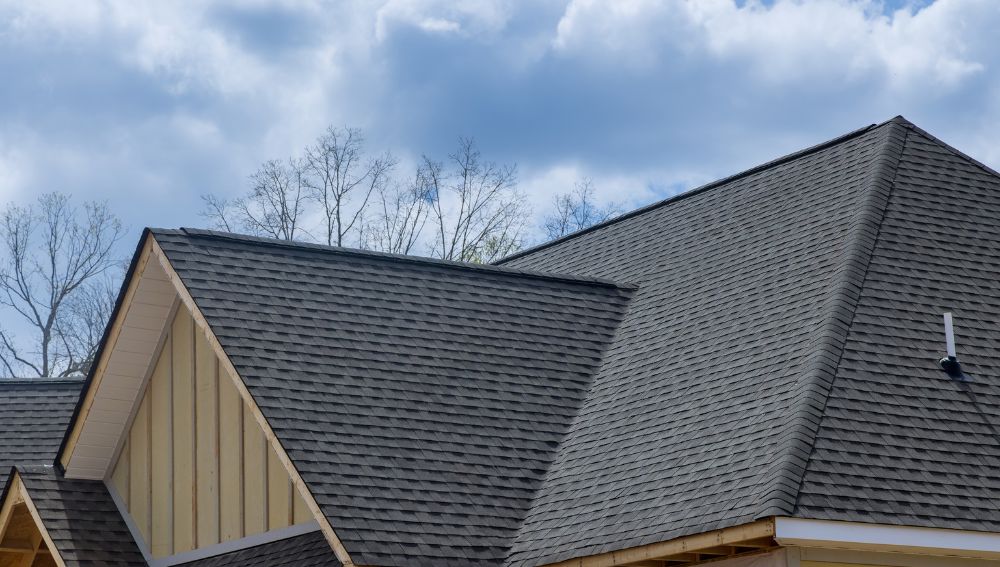
Asphalt shingles are a popular type of roofing material. It’s one of the most sought-after roofing materials because it is easy to install. It is from a mixture of asphalt, fibreglass, and ceramic. There are two significant types of asphalt shingles, namely:
- Organic
- Fiberglass
Asphalt composite shingles have gained immense popularity. It is the go-to roofing material in North America.
Their construction utilizes a combination of:
- Fiberglass
- Cellulose
covered in asphalt granules, it has made them an ideal choice for a wide range of home roofing needs. In this article, we will delve into the benefits and features of:
- Asphalt Shingles
highlighting their:
- Durability
- Versatility
- Ease of Installation
Fiberglass asphalt shingles are a popular choice due to their lightweight yet durable nature. Despite being lightweight, these shingles offer impressive strength and resilience. But, organic asphalt shingles, although heavier, still provide excellent durability. Their flexibility allows them to adapt to the natural expansion and contraction of the roof. They make them a reliable option for homeowners.
One of the primary advantages of asphalt shingles is their straightforward installation process. Due to their widespread usage, almost every roofing company is familiar with their installation requirements. Moreover, in the event of damage, replacing individual shingles is somewhat simple. Most asphalt shingles come with a 20- to 30-year warranty. They provide homeowners with long-lasting protection and peace of mind.
Asphalt shingles offer homeowners an extensive selection of textures and colors to choose from. The two most widespread types are strip or laminated asphalt shingles. Strip shingles provide a clean and uniform look. Laminated shingles create a dimensional and layered appearance. This versatility allows homeowners to find the perfect shingle design. It complements their home’s architectural style and personal taste.
One of the standout benefits of asphalt shingles is their affordability. They provide excellent durability for their price, making them a cost-effective roofing solution. When installed and maintained the correct way, asphalt shingles can withstand various weather conditions. The weather varies from heavy rain to windstorms. Regular inspections and timely repairs ensure their longevity. It makes asphalt shingles a smart investment for homeowners.
To ensure the longevity of an asphalt shingle roof, proper ventilation is crucial. Adequate airflow helps to prevent moisture buildup and prolongs the lifespan of the shingles. Have a professional roofer assess and maintain the ventilation system often. Additionally, homeowners should inspect their shingles after major hail or windstorms. It’s needed to identify any potential damage that may need immediate repair.
Asphalt shingles offer homeowners an array of benefits, including:
- Their Lightweight Yet Durable Construction
- Easy Installation and Repair Processes
- A Wide Variety of Textures and Colors
With affordability and longevity in mind, asphalt shingles continue to be a practical choice. It fits for both new roof installations and replacements. Asphalt shingles will ensure your roof stands the test of time with:
- Regular maintenance
- Proper ventilation
- Timely repairs
They provide you with reliable protection and enhance the aesthetics of your home.
Pros
- It is relatively affordable
Asphalt shingles are less expensive than other roofing materials.
- Easy installation process
Asphalt shingles are easy to install, and it saves labor costs. The easy installation process is why it is popular among professional contractors.
- Variety of styles, colors, and designs
Asphalt shingles come in different styles, techniques, and colors, giving buyers an extended range of options, and it’s easier to find something that complements your home.
- Resistant to fire
Fiberglass shingles have a resistance to fire, and it also helps to stop the spreading of fire.
- Weather resistant
Asphalt shingles are weather resistant. They can protect your house from weather damage.
- Soundproof
Asphalt shingles aren’t entirely soundproof, but they can help reduce the noise levels inside your home and absorb sound waves well.
- Resale value
A properly maintained asphalt shingles roof can immediately add value to your home and attract potential buyers.
Cons
- Short lifespan
Compared to other roofing materials, asphalt shingles have a short lifespan. They last from about 15-30 years, depending on the quality of the shingles and the climate under which they got installed.
- Durability
Asphalt shingles would likely suffer damage from severe weather, such as heavy rain, windstorm, and high winds.
- Environmental impact
You most likely won’t say asphalt shingles and environmentally friendly in the same sentence because they are made from non-renewable resources and can’t be easily recycled, making them not ecologically friendly.
2. Metal roofing
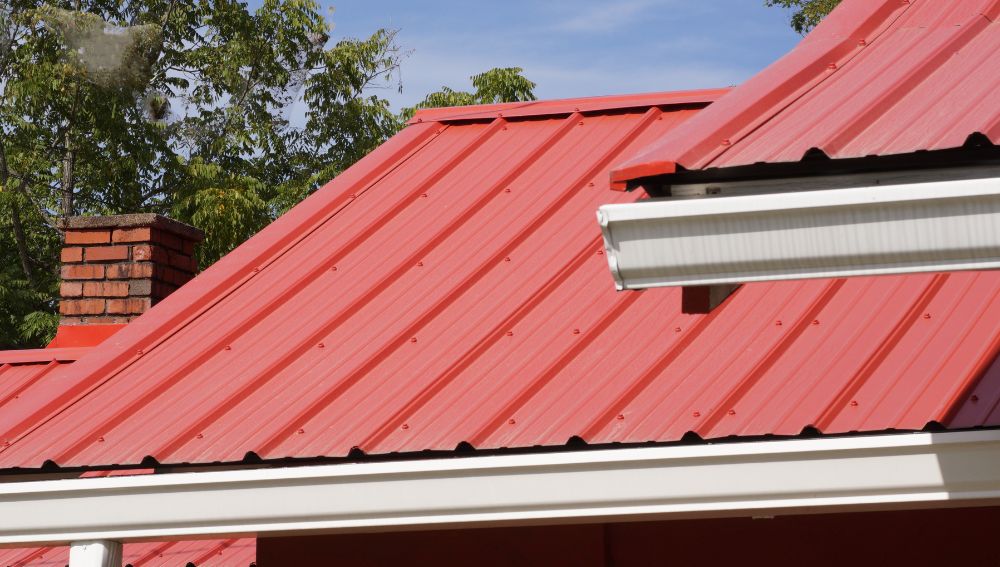
Metal roofing has become a popular choice for homeowners. Are you looking for a durable and long-lasting roofing material that adds aesthetic appeal to your home? Metal tiles offer a wide range of benefits, including:
- Longevity
- Durability
- Energy Efficiency
- Low Maintenance
- Eco-Friendliness
We will focus on metal shingles and shakes, which are an ideal option for homeowners. When you desire the advantages of metal roofing without the conventional standing seam look, you need this roofing type.
Manufacturers fabricate metal shingles and shakes from stamped metal. They finish with either a high-quality baked-on coating or mineral granules. The result is a roofing material that looks like:
- Traditional Asphalt Shingles
- Wooden Shakes
- Slate or Clay Tiles
This flexibility in design allows homeowners to choose the perfect style. The goal is to complement the architecture and style of their homes. This feature ensures homeowners do not have to compromise on aesthetic appeal. Their quest for a durable and long-lasting roofing solution ended with positive results.
Manufacturers build metal shingles and shakes to last. They can provide homeowners with 30 to 50 years of reliable protection while maintaining their aesthetic appeal. They can withstand various weather conditions, such as:
- Strong Winds
- Heavy Rain
- Snow and Hail
They make them a popular choice with homeowners in regions with extreme weather patterns.
Metal roofing has energy-efficient properties. Metal reflects a significant amount of solar radiant heat. It reduces the workload on air conditioning systems during hot summer months. Installing metal shingles and shakes with extra insulation further enhances their energy efficiency. This efficiency translates to lower energy bills. It makes them an efficient long-term choice for homeowners.
Compared to other roofing components, metal shingles and shakes need minimal maintenance. Homeowners only need to clean them often. They need to conduct routine inspections to ensure they remain in optimal condition. Metal shingles and shakes are not prone to common roofing issues such as:
- Rotting
- Cracking
- Insect Infestations
. . . which keeps maintenance costs low in the long run.
Metal roofing is a friendly environmental choice for roofing solutions. Metal shingles and shakes often contain recycled materials, making them sustainable choices. Additionally, metal roofing is recyclable at the end of its lifespan, reducing the amount of roofing waste in landfills.
Metal shingles and shakes offer homeowners a reliable and appealing roofing solution. Their design flexibility enables homeowners to match their roofing material to their home’s architectural style. They are durable, energy-efficient, low maintenance, and eco-friendly. The longevity and low maintenance costs translate to cost-effective choices for homes. By incorporating metal shingles or shakes, homeowners can enjoy the benefits of metal roofing. They do this without sacrificing their aesthetic preferences.
Pros
- Metal roofing is highly durable, lasting up to 50 years if properly and carefully installed and maintained.
- It is less likely to suffer from weather damage.
- Metal roofing is not expensive to maintain, and they require little maintenance
- It is resistant to fire.
- Metal roofing gives a modern, attractive look at buildings.
- It is 100 percent recyclable, making it environmentally friendly.
Cons
- Metal roofing can be more high-priced than other roofing material
- Metal roofing is not soundproof so it can get noisy during rainstorms.
- Metal roofing is difficult to install, requiring a certain level of expertise and tools.
3. Slate roofing
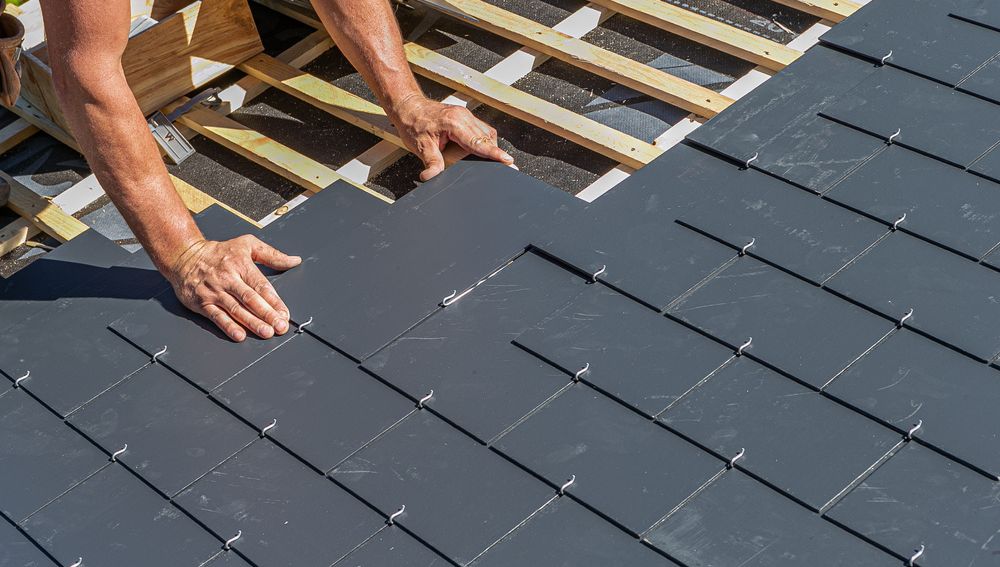
Slate roofing has been a popular choice for homeowners for centuries due to its durability and aesthetic appeal. Slate makes it an excellent choice for homeowners due to:
- The natural beauty of slate
- Ability to withstand harsh weather conditions
. . . looking for a long-lasting roofing solution for their homes. Despite being popular, slate roofing has certain limitations, including its:
- Weight
- Installation Difficulty
- Repair
In this article, we will explore the features and benefits of slate roofing. Among the topics we will cover include:
- Durability
- Longevity
- Attractive Appearance
Slate roof tiles are thin, natural sheets of stone that come in a wide range of colors, including:
- Gray
- Black
- Green
- Purple
As a result, homeowners can choose a slate color that complements their home’s aesthetics and style. The unique texture and natural variation between slate tiles create a:
- Timeless
- Authentic Look
It adds aesthetic value to any home. Moreover, the natural aging of slate tiles imparts a pleasant patina over the years. It enhances the roof’s charming aesthetics.
Slate roofing top qualities are:
- Durability
- Fire-Resistant
Withstand Extreme Weather Conditions such as:
- Wind
- Rain
- Snow
- Hail
As a result, slate roofs need little maintenance. They are unlikely to experience damage that would need replacement. The lifespan of a slate roof installed with care can range from 75 to 150 years. It offers homeowners unparalleled longevity.
Slate roofing’s high price and weight are limitations that homeowners should consider. The installation and repair of slate need:
- High-level specialized skills
- Top Rated Equipment
It makes it an expensive roofing option. Furthermore, Slate’s weight can be a limiting factor. Not all homes can support its weight. Yet, if a homeowner is willing to invest upfront, their investment translates to long-term benefits.
Installation of slate roofing requires top-specialized skills and equipment. Seek professional advice during installation to ensure their new slate roof will last for years to come. Employing a qualified specialist to install a slate roofing system ensures the roof will look and function well for decades.
Slate roofing is a timeless and durable roofing solution. It adds authenticity and charm to homes. Slate tiles are available in a wide range of colors, making them an excellent aesthetic choice for homeowners. Despite their high cost and weight, slate roofing’s durability and longevity pay off for the homeowner in the long term. A slate roof installed by specialists can last 75 to 150 years or more. It makes it a smart investment for homeowners looking for a reliable and long-lasting roofing solution.
4. Clay Tile Roofing
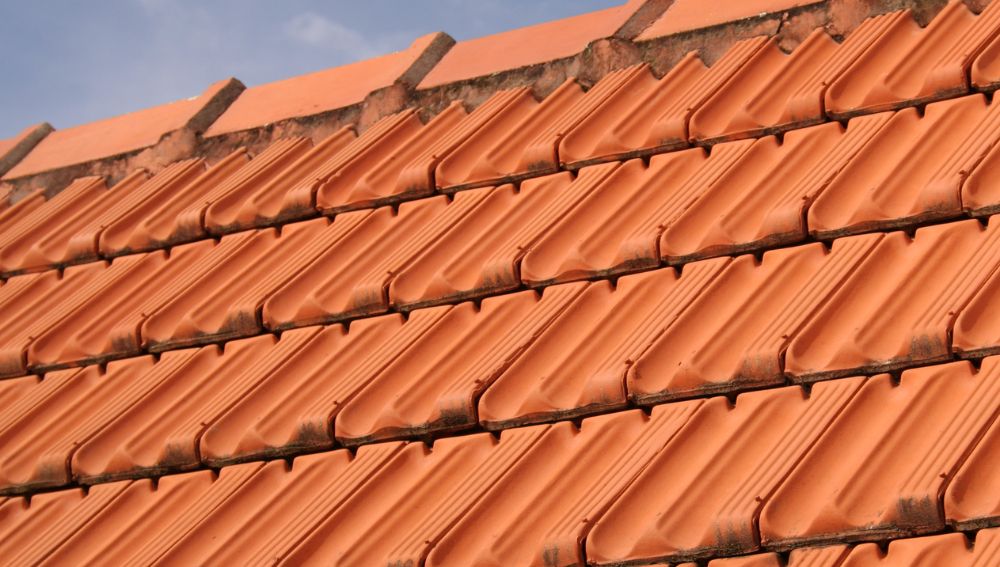
Clay tile roofing is a natural and durable option for homeowners looking for a long-lasting solution for their home’s roof. The earthen clay used in manufacturing clay tiles makes them ideal for hot climate regions. They are popular in southern coastal and desert areas. They are also easy to maintain because of their ability to absorb less moisture, making them a practical roof option. Yet, the high cost of clay tiles and their fragility make them a limited roofing option. In this article, we will explore the:
- Features
- Benefits
. . . of clay tile roofing, including their durability, aesthetic appeal, and suitability for homes in hot climates.
Clay tiles are one of the most durable natural roofing materials. They can withstand extreme weather conditions, such as heavy wind, rain, and hail, making them ideal for homes in hot climate regions. Clay tiles are also fire-resistant, preventing heat from spreading during a fire hazard. With proper installation and maintenance, clay tiles can last for over a century. They provide homeowners with a long-lasting roofing solution.
Clay tiles offer a rustic and traditional aesthetic to homes. They create a timeless and authentic look:
- Reddish-orange color
- Unglazed texture
They enhance any home’s curb appeal. Clay tiles are available in various shapes:
- Classic barrel shape
- Interlocking tiles
They enable homeowners to choose the perfect style. The idea is to complement their home’s architectural design.
Clay tiles are an excellent roofing option for homes in hot climates. They have the ability to:
- Absorb less moisture
Reduce the risk of:
- Mold
- Mildew growth
- Prevent premature decay
Their dense structure also helps:
- Regulate indoor temperature
- Keep homes cooler during the hot season
The high cost of clay tiles is a limitation that homeowners should consider. Although they offer long-term durability and aesthetic appeal, their initial cost is high. Yet, in the long run, the benefits of clay tiles outweigh the upfront costs. They do not need frequent repairs or replacement like other roofing materials.
Clay tiles are fragile and can break with ease making them difficult to work on during installation or repair. Homeowners should use qualified professionals with experience in clay tile roofing. They need to ensure that the installation and repair process does not cause any significant damage to the tiles.
Clay tile roofing is a durable and beautiful roofing option suitable for homes in hot climates. Its natural, unglazed texture creates an authentic look that enhances any home’s aesthetics. Clay tiles:
- Exceptional durability
- Ability to absorb less moisture
. . . provides homeowners with a long-lasting and low-maintenance roofing solution.
Although clay tiles’ upfront cost is high, their long-term benefits make them a wise investment. These are perfect for homeowners seeking a reliable and long-lasting roofing solution.
Pros
- Long lasting: Clay tiles can last for 50 years or more.
- Environmental friendly: Clay tiles are more environmentally friendly because they are byproducts of natural materials that you can easily recycle for something different.
- Resale value: Well-maintained clay tiles are more attractive to potential buyers
- Low cost to maintenance: Clay tiles require little maintenance, and damages are easy to repair
Cons
- Tiles are brittle: They can break or crack if walked on or hit by heavy objects.
- Complex installation: Clay tiles are the most challenging type of roofing materials to install.
- High cost: Clay tiles are more expensive than other roofing materials
- Heavyweight: Clay tiles are heavy; this is one of the reasons they are difficult to install, and they need more support when installed.
5. Concrete Tile Roofing
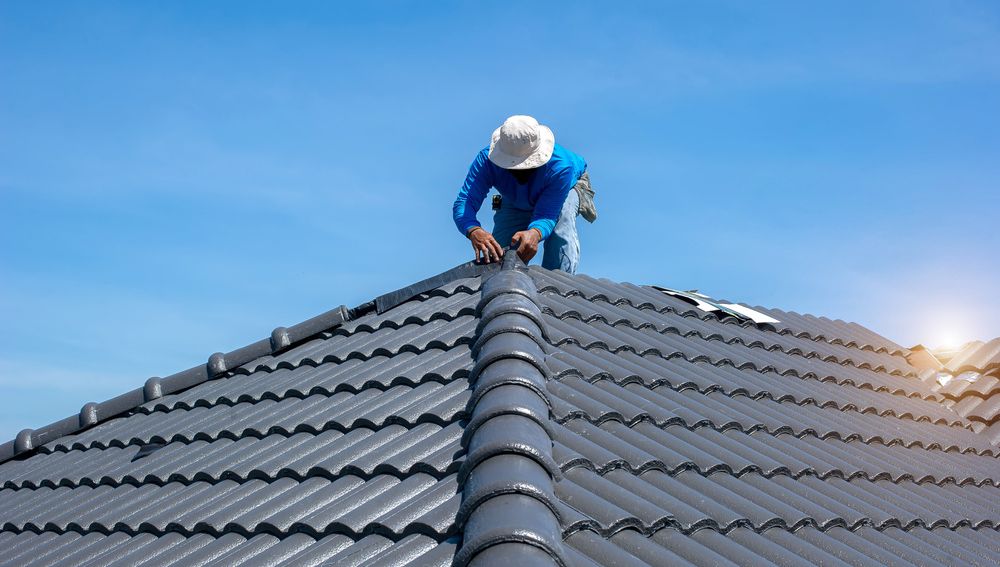
Concrete tile roofing offers homeowners a:
- Durable
- Versatile
. . . alternative for their roofing needs. These tiles can mimic the appearance of various materials, including:
- Asphalt
- Slate
- Wood Shingles
Roofers know concrete tiles for their affordability. When you compare concrete tiles to other options like clay, they provide longevity. Yet, due to their weight and water absorption, homeowners should consider the impact on the structure of their homes. It’s best to get ready for regular maintenance. In this article, we will explore the:
- Features
- Benefits
. . . of concrete tile roofing, including its:
- Durability
- Versatility
- Cost-Effectiveness
Concrete tile roofing is:
- Durable
- Withstand various weather conditions
- High winds
These tiles are:
- Strong
- Resistant to fire
. . . making them a reliable choice for homeowners seeking a long-lasting roofing solution.
With proper:
- Installation
- Maintenance
. . . concrete tile roofs have a life expectancy of 50 years or longer, providing homeowners with peace of mind and value for their investment.
Concrete tiles offer a wide range of design options. They allow homeowners to achieve the desired appearance of:
- Asphalt
- Slate
- Wood Shingles
Whether it’s the charm of:
- A slate roof
- The rustic appeal of wood shakes
. . . concrete tiles can mimic different materials while providing the:
- Durability
- Longevity
. . . associated with concrete. Homeowners have the flexibility to choose from various profiles. Colors complement their home’s architectural style and personal aesthetics.
Concrete tile roofing is a cost-effective option. This is the case when compared to premium materials like clay. While offering similar:
- Advantages
- Installation techniques such as clay tile roofs
. . . concrete tiles often come at a lower cost. This makes them an attractive choice for homeowners who seek:
- Durability
- Style
. . . on a more affordable budget.
It is crucial to consider the weight and water absorption characteristics of concrete tiles. Their weight can exert stress on the home’s structure. It requires adequate reinforcement and evaluation by a professional. Professionals recommend regular maintenance to prevent:
- Water accumulation
- Potential damage
. . . caused by moisture absorption. Homeowners should be ready for occasional repairs and upkeep. The goal is to ensure the longevity of their concrete tile roof.
Concrete tile roofing is a:
- Durable
- Versatile
. . . option for homeowners looking for a cost-effective roofing solution. Their ability to mimic various:
- Materials
- Styles
. . . offer homeowners flexibility in achieving their desired aesthetics. With proper maintenance, concrete tile roofs can last for 50 years or more. They provide homeowners with long-lasting protection for their homes. Be mindful of the:
- Weight
- Water absorption
. . . aspects of concrete tiles, ensuring:
- Proper Reinforcement
- Regular Maintenance
. . . to maximize the lifespan of the roof. Concrete tile roofing offers a winning combination of:
- Durability
- Versatility
- Affordability
. . . for homeowners in search of a reliable roofing choice.
Pros
- Concrete tiles are quite durable, and last a long time; so far, they have been installed correctly.
- Concrete tiles are versatile. They come in different styles, patterns, and designs.
- They require little maintenance
- Resistant to fire
- Concrete tiles cause no harm to the environment and can be recycled.
Cons
- They are expensive
- Concrete tiles weigh more, and they are heavy
- They are fragile and can break if not handled with care
- They can be more challenging to install, and they require particular tools
6. Wood Shingles and Shakes
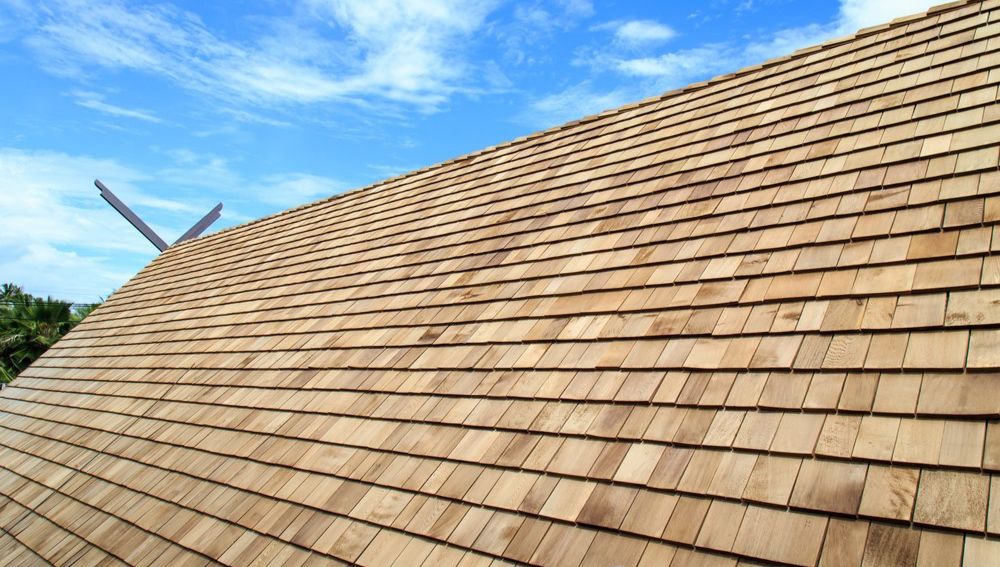
Wood roofing has a timeless appeal, offering a beautiful and rustic option known for its durability and energy efficiency. Yet, it is vital to be aware of the higher cost of installation and maintenance that comes with wood roofing. Regular upkeep is necessary to avoid severe damage and maintain the roof’s effectiveness. In this article, we will explore wood shingles and shakes:
- Features
- Limitations
- Longevity
We will aim to shed light on their attractiveness and considerations for homeowners.
Wood shingles and shakes can provide a durable roofing solution when given proper care. They are often made from cedar or redwood. These natural wood materials can withstand moderate weather conditions. Yet, their longevity can vary depending on factors such as climate and maintenance. In drier climates, a wood shingle or shake roof can last up to 60 years, while in damp conditions, the lifespan may range from 20 to 30 years.
Consider wood roofing a high-end option, and its cost reflects this. The average price for wood shingles ranges from $4.50 to $9 per square foot, while wood shakes often cost between $6.50 and $14 per square foot. Homeowners should check their budgets. Consider long-term financial implications. They should opt for wood roofing, due to the initial expense and ongoing maintenance costs.
Wood shingles and shakes have limitations and may not be suitable for all environments. Not recommended for regions with high moisture levels or areas prone to wildfires. Moisture can lead to rot, mold, and other issues. The combustible nature of wood makes it a fire risk in fire-prone areas. Homeowners should consider local climate and hazards before choosing wood roofing as an option.
While both wood shingles and shakes come from natural wood, there is a difference in their production methods and appearance. Shingles are:
- Thin
- Wedge-Shaped Slabs
. . . made through precise sawing.
Shakes are thicker wedges created by splitting the wood, resulting in a rougher texture. Homeowners can choose the style that best suits them. Their goal is their desired aesthetic and architectural preferences.
Wood shingles and shakes offer a timeless and charming option for homeowners. They sometimes seek a rustic and durable roofing material. While their:
- Beauty
- Energy efficiency
. . . are undeniable, it is important to be aware of the higher installation and maintenance costs associated with wood roofing.
Proper maintenance is necessary to ensure its longevity. This is an interest, particularly in areas with moisture concerns. Understanding the limitations and considering local factors is crucial. Homeowners can make an informed decision and enjoy the unique appeal of wood shingles and shakes for their roofs.
Pros
- Aesthetic appeal.
- They help keep a house warm in cooler seasons .
- Wood shingles are made from natural materials, which makes them friendly to the environment.
- Wood shingles are lightweight, so they don’t need extra structure to stay in place.
- Easy installation.
Cons
- Wood shingles are highly flammable and can increase the risk of fire
- They are more expensive than other roofing materials
- Wood shingles are high maintenance. They require regular cleaning and treatment to prevent decay and mold growth. Wood shingles are prone to moisture and insects.
7. Synthetic or Composite Roofing Materials
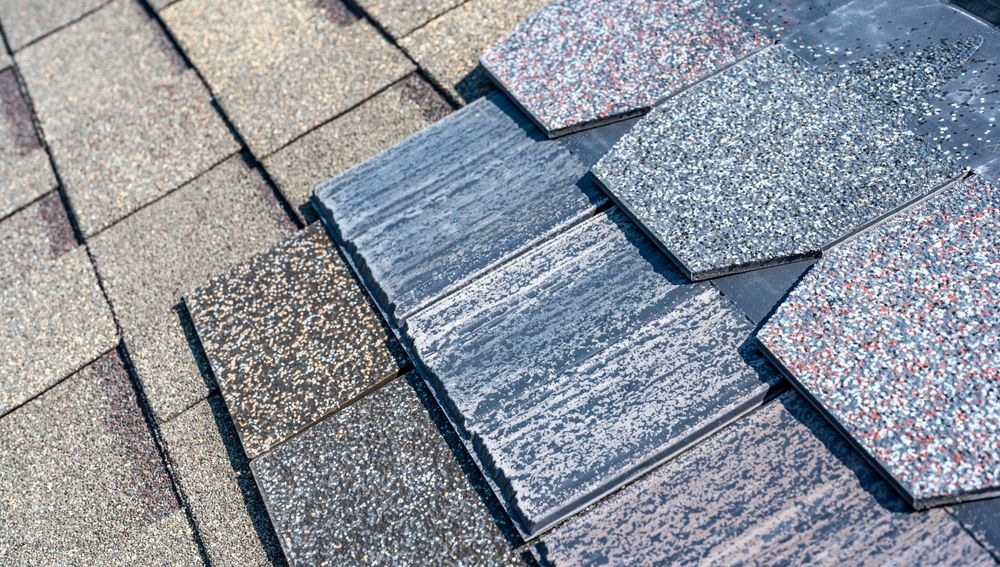
Synthetic or composite roofing materials offer homeowners a:
- Lightweight
- Durable
- Cost-effective
. . . alternative for their roofs. With high impact and fire ratings, synthetic roofs provide the desired level of protection and peace of mind. Available in a variety of attractive styles. These include slate and cedar shake. Synthetic roofing provides an accessible and low-maintenance solution. It can last for many years. In this article, we will explore the features and benefits of synthetic composite roofing materials. It includes their affordability, durability, and visual appeal.
Synthetic roofing materials, such as rubber slate tiles, offer an affordable option for homeowners. The average cost of synthetic slate is around $9 to $12 per square foot, making it a more cost-effective alternative to natural slate. This accessibility allows more homeowners to enjoy the aesthetic appeal. It offers the benefits of a slate-like roof without the high price tag.
While synthetic slate may not be as durable as natural stone, it still provides impressive longevity and protection. Slate roofs are:
- Lightweight
- Resistant to Impact
- Fire
- Engineered from Polymers
- Recycled Plastic
- Rubber
- Synthetic
Synthetic roofs can withstand the elements with proper installation and maintenance. It offers reliable protection for decades. Many synthetic slate products come with warranties of up to 50 years, providing further assurance of their durability.
One of the main advantages of synthetic roofing materials is their ability to mimic the appearance of natural slate or cedar shake.
From the ground, it can be challenging to distinguish synthetic roofing from the real thing. This advantage allows homeowners to achieve the desired aesthetics. They don’t have the structural limitations or costs associated with natural materials. Synthetic composite roofing provides a wide range of styles and colors. It allows homeowners to find the perfect match for their architectural preferences. It also enhances the attractiveness of their homes.
Synthetic roofs are maintenance-free, making them an attractive choice for homeowners. Most people seek a hassle-free solution. Unlike natural materials that may need regular:
- Cleaning
- Repairs
- Treatments
. . . synthetic roofing materials can withstand the test of time with minimal upkeep. These features can save homeowners valuable time and money on maintenance tasks. It allows them to focus on enjoying their durable and appealing roof.
Synthetic composite roofing materials offer homeowners a:
- Cost-effective
- Durable
- Appealing option for their roofs
Synthetic roofs provide a reliable and attractive alternative to natural materials like slate. They furnish affordability, excellent warranties, and low maintenance needs. Homeowners can enjoy the aesthetic appeal of slate or cedar shake. They do it without the associated high costs, weight limitations, or ongoing maintenance needs. With synthetic roofing, homeowners can achieve a durable and stylish roof. It enhances the beauty and protection of their homes for years to come.
8. Built-up roofing (BUR) or Tar and Gravel Roofing
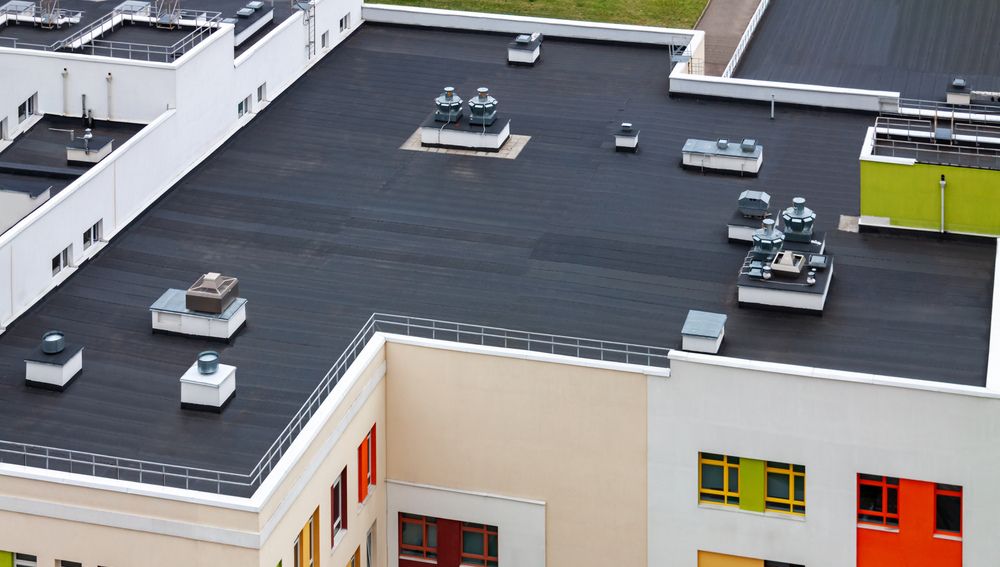
Built-up roofing (BUR), also known as tar and gravel roofing, has a long history as a popular choice for flat or low-pitch roofs. It offers excellent protection against water, UV rays, and severe weather conditions. Additionally, BUR is low maintenance, affordable, and easy to repair or replace. Yet, it is crucial to be aware of the:
- Labor-Intensive Installation Process
- Potential Fume Emissions
- Challenges in Locating Leaks
We will explore the features, cost, durability, and considerations associated with built-up roofing.
Built-up roofing provides effective waterproofing and durability due to its many layers. The process involves applying several layers of asphalt-impregnated roofing felt. Then create a barrier that is two to four layers thick. This is then topped with a layer of hot tar and small crushed stones. The resulting roof would be very resistant to water penetration. It offers exceptional protection against external elements like UV rays. It also protects the property against severe weather conditions.
Built-up roofing is an affordable option for flat or low-pitch roofs. It has an average cost ranging from $2.50 to $5 per square foot. This makes it an affordable choice for homeowners. Homeowners seek a durable and long-lasting roofing solution without breaking the bank. Yet, it is crucial to factor in extra costs for professional installation. It is also a potential maintenance or repair expenses over the roof’s lifespan.
When properly installed, a built-up roof – BUR – can last between 20 and 30 years. BUR is durable and resistant to wear due to the:
- Many layers of asphalt-impregnated felt
- Protective layer of hot tar
- Crushed stone
Regular maintenance, such as clearing debris and inspections, can help extend the lifespan of the roof. It helps identify any potential issues early on.
The installation process for BUR is slow and labor-intensive, typically requiring professional expertise. The use of hot tar during installation can release hazardous fumes, making proper ventilation crucial. Locating and repairing leaks in a built-up roof can be challenging compared to other roofing systems. Roofers need specialized equipment and expertise. They use it to pinpoint and address leaks effectively.
Built-up roofing, or tar and gravel roofing, offers homeowners an affordable and durable option for flat or low-pitch roofs. Its multiple asphalt layers provide:
- Effective protection against water
- UV rays
- Severe weather
These layers come felt impregnated, topped with hot tar and crushed stone. BUR remains a reliable and cost-effective choice for homeowners. The installation process is labor-intensive, and locating leaks can be challenging. It helps when seeking a long-lasting and low-maintenance roofing solution. With proper care and maintenance, a built-up roof can provide reliable protection for 20 to 30 years.
9. Modified Bitumen Roofing
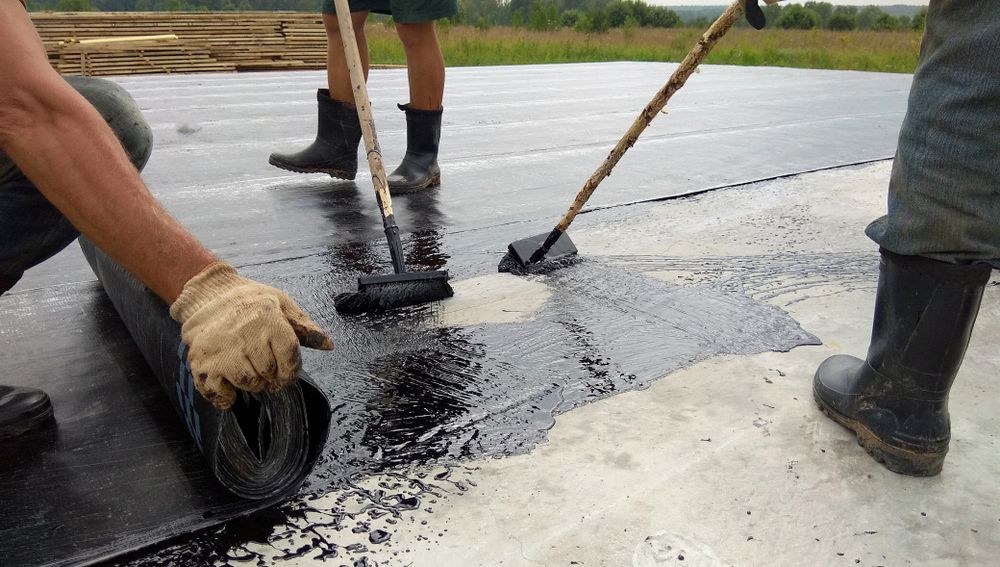
Modified bitumen roofing has emerged as a leading commercial roofing system. Roofers have come to know bitumen roofing over the past half-century. Recognized for its durability, tensile strength, and ease of installation. Modified bitumen roofing has evolved from an experimental innovation to a versatile system. It has become the preferred choice for millions of projects worldwide. Modified bitumen roofing is mainly used on flat or low-slope commercial roofs. Designed with a rugged yet flexible waterproof membrane. We will delve into the features, benefits, and types of modified bitumen roofing.to help you make an informed decision for your next project.
Modified bitumen roofing is an advancement of built-up roofing systems (BURs). The roofing industry has seen its use for over 100 years. Made of asphalt blended with polymerized rubber or plastic. Reinforced with fiberglass to create a durable and flexible waterproof layer. Its main focus is on commercial spaces on flat or low-sloping roofs in multi-ply systems. Generally composed of two or more layers.
Modified bitumen is available in two forms, known as APP and SBS. APP is a blend of asphalt and plasticized polymers that become elastic at high temperatures, known as “plastic asphalt”. APP membranes have excellent resistance against UV rays and are great for cool roofs. SBS or “rubberized asphalt” is a blend of asphalt with polymerized rubber. It provides excellent elasticity and flexibility for roof buildings. These rooftops experience extreme temperature changes and wind uplift.
The modified bitumen roofing material is available in rolls. Installed directly onto the substrate with an adhesive. Done through cold adhesion, heat-welding, or self-adhesion. Mechanical fastening methods are also possible, with at least two layers setup.
Modified bitumen roofing’s primary benefits are its exceptional waterproofing, durability, and strength. Designed to withstand extreme weather conditions. The various layers provide a thickness that enhances puncture resistance. It is low maintenance, has an extended lifespan, and is excellent at serving commercial spaces with flat or low-slope roofs.
Modified bitumen roofing is an ideal roofing system for commercial buildings. It fits best for flat or low-sloping roofs. The modified bitumen roofing waterproof membrane is resistant to extreme weather conditions. It is available in multiple layers, providing added puncture resistance. APP and SBS are the most popular available types. Roofers install them with mechanical and adhesive methods. The primary benefits of modified bitumen roofing are its strength, durability, and low maintenance. These qualities make it a cost-effective roofing option. You can make an informed decision on the right roofing material for your next project..
10. Single-ply roofing (such as EPDM, TPO, or PVC)
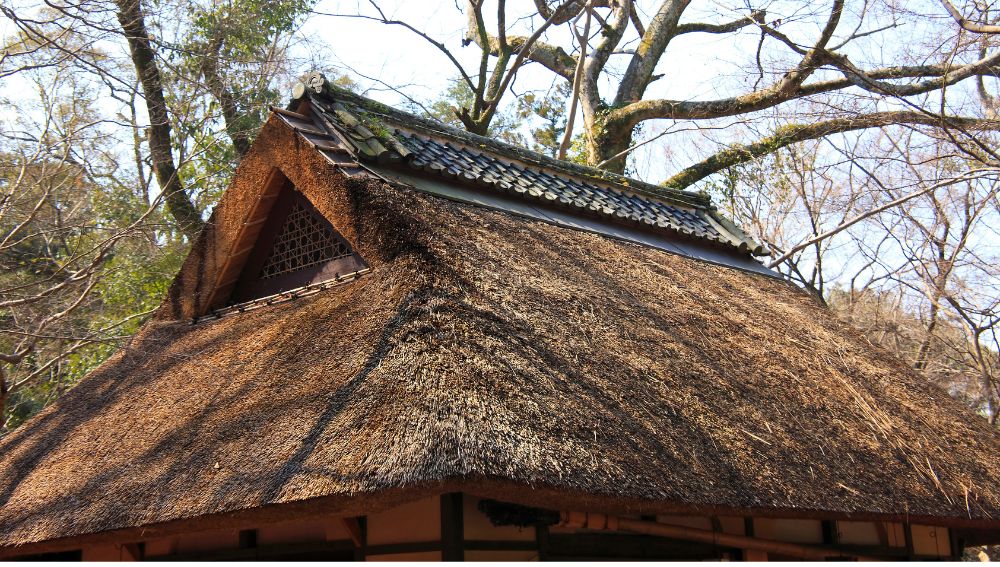
EPDM (Ethylene Propylene Diene Terpolymer) roofing is a type of synthetic rubber roofing membrane. It has gained popularity for its durability, flexibility, and excellent weather resistance. EPDM roofs are popular for low-slope and flat commercial and residential roofs. We will explore the EPDM roofs:
Features
- Benefits
- Installation Methods
- Maintenance Considerations
Durability: EPDM is popular for its exceptional durability. It has a typical lifespan ranging from 20 to 30 years. EPDM roofs can withstand extreme weather conditions, including strong winds, hail, and UV radiation.
Flexibility: Very flexible EPDM roof. It can accommodate building movement without cracking or becoming damaged. This flexibility is particularly beneficial in areas prone to temperature fluctuations.
Weather resistance: EPDM roofs have excellent resistance to extreme temperatures, ozone, and moisture. They can withstand prolonged exposure to sunlight without significant degradation.
Low maintenance: EPDM roofs need minimal maintenance. They do not accumulate debris and are resistant to mold, mildew, and algae growth. Regular inspections and occasional cleaning are usually enough to keep the roof in good condition.
Cost-effective: EPDM roofs are affordable compared to other commercial roofing options. They have a low installation cost. They need minimal maintenance throughout their lifespan, making them a cost-effective choice.
Energy efficient: EPDM roofs are available with reflective coatings. It can help reduce energy consumption by reflecting sunlight and reducing heat absorption. This results in lower cooling costs in hot climates.
Easy installation: EPDM roofs are often installed in large sheets. Roofers adhere them to the roof substrate. They can also attach them through mechanical means. The installation process is quite quick and straightforward, which can save time and labor costs.
Fully adhered: This method involves using adhesives to glue the EPDM membrane right on the roof substrate.
Use mechanical attachments:
Secure EPDM membrane to the roof substrate using mechanical fasteners like screws or plates.
Ballasted: In this method, the EPDM membrane is loose-laid over the roof substrate. Held in place with the weight of ballast materials, such as gravel or concrete pavers.
To ensure the longevity and performance of an EPDM roof, recommended regular maintenance includes:
Visual inspections: Inspect the roof at regular intervals for any signs of damage, such as punctures or tears. Address any issues on time to prevent further damage.
Cleaning: Remove debris, leaves, and other elements that may accumulate on the roof surface. Use a gentle cleaner and soft brush to clean the EPDM membrane if necessary.
Seam and Flashing Maintenance: Check the integrity of seams and flashing. Ensure to seal them properly. Repair any visible damage or signs of deterioration.
Professional Inspections: Roofers suggest having a professional roofing contractor perform periodic inspections. Identify any potential issues and ensure the roof is in good condition.
EPDM roofs are a popular choice for commercial and residential buildings. Often used with low-slope or flat roofs. They offer durability, flexibility, weather resistance, and low maintenance requirements. EPDM roofs are cost-effective, energy-efficient, and quite easy to install. Install, maintain, and inspect an EPDM roof. You can enjoy its long lifespan and reliable performance for many years to come.
TPO (Thermoplastic Olefin) roofing is a popular choice for commercial and residential buildings due to its durability, energy efficiency, and cost-effectiveness. TPO roofing is a single-ply membrane made of synthetics and reinforced scrim, designed to cover flat roofs. Here are some key points about TPO roofs:
TPO roofs are highly durable, capable of withstanding extreme weather conditions, including UV radiation, heat, and chemicals.
TPO roofs have reflective properties that help reduce heat absorption, resulting in lower cooling costs.
TPO roofing is generally more affordable than other commercial roofing options. It offers a good balance between cost and performance.
TPO roofs can be installed using various methods, including mechanically attached, fully adhered, or ballasted installation.
They require regular inspections and maintenance to ensure their longevity and performance. Visual inspections, cleaning, and addressing any issues promptly are necessary for proper maintenance.
These usually have heat-welded seams, providing superior strength and reducing the risk of leaks1.
They come in various colors, allowing for aesthetic customization for different architectural styles4.
It is important to consult with roofing professionals for a thorough understanding of TPO roofing, including material specifications, installation techniques, and ongoing maintenance requirements.
PVC (Polyvinyl Chloride) roofing is a type of single-ply roofing membrane. Used for commercial and industrial roofing applications. Here are some key points about PVC roofs:
PVC roofs are very durable, long-lasting, and resistant to weathering, wind, and chemicals. They can last up to 30 years or more.
PVC roofs feature reflective properties. They help reduce heat absorption, resulting in increased energy savings and reduced cooling costs.
PVC roofs are low maintenance. They only need regular cleaning and inspection to ensure longevity and performance.
Install PVC roofing through various methods, including:
- Attached by Mechanical Means
- Fasten Ballasted with Insulation and Membrane Layer
- Adhered Through Chemical Compounds
Perform regular inspections and maintenance. Include cleaning and addressing any damages. Great for optimal performance and longevity.
PVC roofs can have environmental implications. Made from a synthetic plastic material and can be difficult to recycle.
Fire performance: PVC roofs rated for fire resistance. But extra coatings or fire retardants may be necessary depending on the building and roofing system.
It is critical to work with experienced roofing professionals. Determine if a PVC roof is suitable for your building and its unique needs. This includes understanding factors such as:
- Regional Climate Conditions
- Building Occupancy
- Environmental Factors
- Project Budget
11. Green roofs
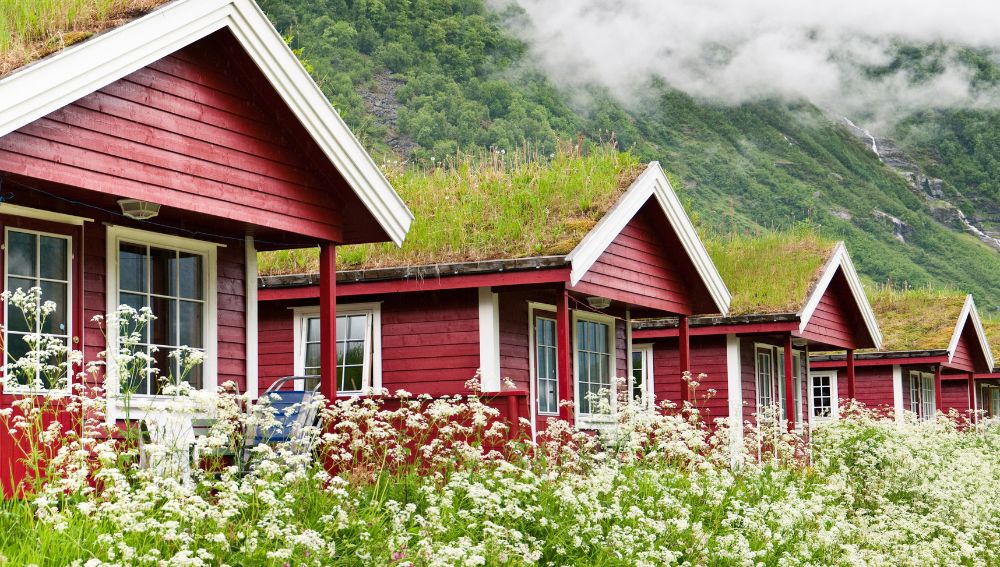
Green roofs, known as living roofs or vegetative roofs, are roofs that are partially or completely covered with vegetation. They offer many environmental benefits. They are becoming popular in both commercial and residential buildings. Here is all you need to know about green roofs:
Extensive Green Roofs
These are lightweight green roofs that often have shallow soil layers. They are low-maintenance vegetation like mosses, serums, and grasses. They need minimal irrigation. You can install them on roofs with lower load-bearing capacities.
Intensive Green Roofs
These are more complex green roofs. They have deeper soil layers that support a wider variety of plants. These plants include shrubs, trees, and even rooftop gardens. Intensive green roofs need more maintenance and have higher load-bearing capacities.
Stormwater Management
Green roofs can absorb and keep rainwater. They reduce the burden on stormwater systems and prevent runoff.
Improved Air Quality
Plants on green roofs absorb pollutants. They filter the air, resulting in improved air quality and reduced urban heat island effect.
Energy Efficiency
Green roofs provide extra insulation. reducing heat transfer and lowering cooling and heating energy requirements.
Biodiversity Support
Green roofs can support the growth of various plant species. They attract birds, bees, and other wildlife, contributing to urban biodiversity.
Extended Roof Lifespan
The vegetation layer protects the roof membrane from:
- UV Radiation
- Extreme Temperatures
- Physical Harm
Thereby extending the roof’s lifespan.
Increased Property Value
Green roofs can increase property values. It is due to their aesthetics and positive environmental impact.
Noise Reduction
Green roofs can act as a natural sound barrier, reducing outside noise pollution.
Enhanced Livability
Rooftop gardens and green spaces provide extra areas for recreation and relaxation.
Installation
Green roofs need careful planning by professional designers and roofing experts. They involve various layers. These layers include a waterproofing membrane, drainage layer, growing medium, and vegetation layer.
Maintenance
Regular maintenance is crucial for the health and longevity of green roofs. This includes irrigation, weeding, fertilization, and monitoring for pests or plant diseases.
Structural Load-Bearing Capacity
Green roofs are heavier than traditional roofs. They need a proper assessment of the building’s structural capacity.
Regional Climate
The choice of plants and maintenance needs will depend on the local climate and ecosystem.
Professional Help
Consulting with experienced green roof professionals is crucial. It helps ensure proper design, installation, and maintenance.
Green roofs offer a range of environmental, economic, and social benefits. They are an attractive option for sustainable building design and urban greening efforts. They help mitigate climate change, improve urban environments, and create enjoyable spaces. Designed for building occupants and the community.
Pros
- Green roofing provides tons of benefits to the environment.
- Green roofs can help reduce energy costs by providing insulation that keeps the building warm.
- They enhance the beauty of a building.
Cons
- Green roofs can be costly to install, requiring ongoing maintenance and irrigation.
- Green roofs are heavier than regular roofing because they need additional structural support.
- Green roofing requires more effort and time to maintain. You must ensure your plants are not pests and insects infested and that your building is not susceptible to water damage.
12. Solar roofing (integrating photovoltaic cells)
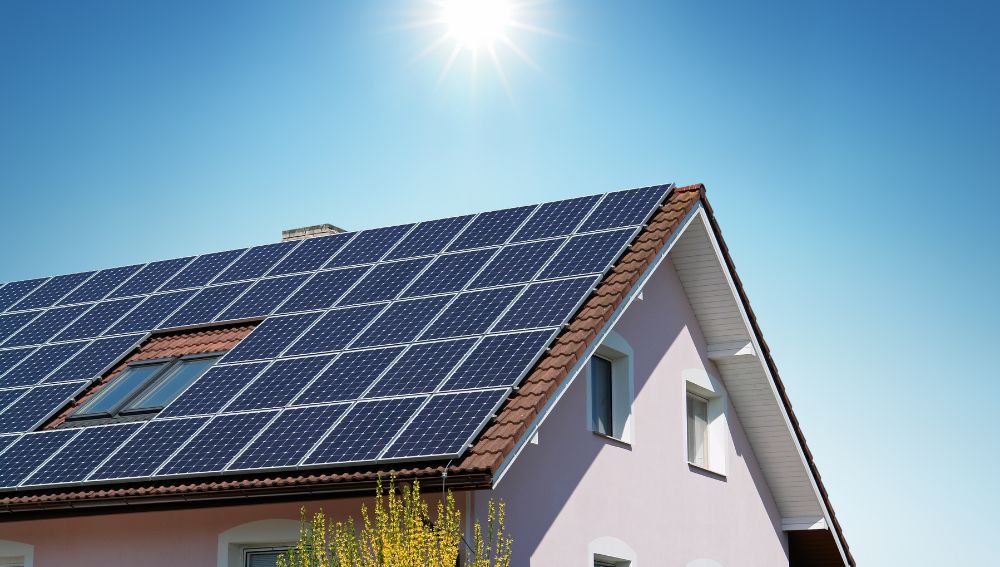
Solar roofing, known as solar roofs or building-integrated photovoltaics (BIPV). It involves integrating photovoltaic (PV) cells directly into the building’s roof. It may also include other architectural elements. Solar Panels integration with roofing materials allows for the generation of electricity. They provide protection and aesthetic appeal. Here is all you need to know about solar roofing with integrated photovoltaic cells:
Solar Shingles
Designed to resemble traditional roofing shingles. They can be seamlessly integrated into the roof. Each solar shingle contains small PV cells that generate electricity when exposed to sunlight.
Solar Tiles
Like solar shingles, design solar tiles to mimic traditional roof tiles. They contain PV cells, and you can use them in place of regular tiles.
Solar Panels
Install traditional solar panel systems on roofs. Mount these panels onto the roof, either flush with the surface or angled to optimize sunlight exposure.
Electricity Generation
Solar roofing systems generate clean, renewable energy, reducing dependence on traditional fossil-fuel-generated electricity.
Cost Savings
Solar roofs can have a large lower electricity bills. by harnessing the sun’s energy to power the building.
Environmental Impact
Solar energy is a clean and sustainable source of power. It reduces greenhouse gas emissions and combats climate change.
Longevity
Build solar roofs to withstand weather elements. They have a long lifespan, often lasting 25 to 30 years or more.
Aesthetics
Solar shingles and tiles can have a seamless integration with the roof. They provide an aesthetically pleasing alternative to traditional solar panels.
Increased Property Value
Solar roofing systems can increase property value. Seen as a valuable addition considering energy efficiency and sustainability.
Solar roofing installation often involves working with solar energy professionals. It also involves roofing contractors with experience in installing PV systems. The integration process may vary depending on the specific system used.
Regular maintenance, such as cleaning the panels to remove dirt and debris, is necessary to ensure optimal performance. Some systems have automated cleaning mechanisms, while others may need manual cleaning.
Solar Potential
It is crucial before installing a solar roofing system to justify the investment:
- Assess The Building’s Solar Access
- Determine Sunlight Availability
Roof Condition
The existing roof should be in good condition before installing solar roofing. Consider any necessary repairs or replacements before installation.
Local Regulations and Permits
Check local regulations about solar installations:
- Get all necessary permits
- Ensure compliance with building codes
- Meet grid interconnection requirements
Solar roofing with integrated photovoltaic cells is an innovative solution. They generate clean energy while ensuring the protection and functionality of the building’s roof. It offers various financial, environmental, and aesthetic benefits. They contribute to sustainable and energy-efficient building practices. Consulting with solar energy professionals and roofing experts is essential. It helps determine the most suitable solar roofing system for your specific needs.
13. Fiberglass or Cellulose Insulation Roofing systems
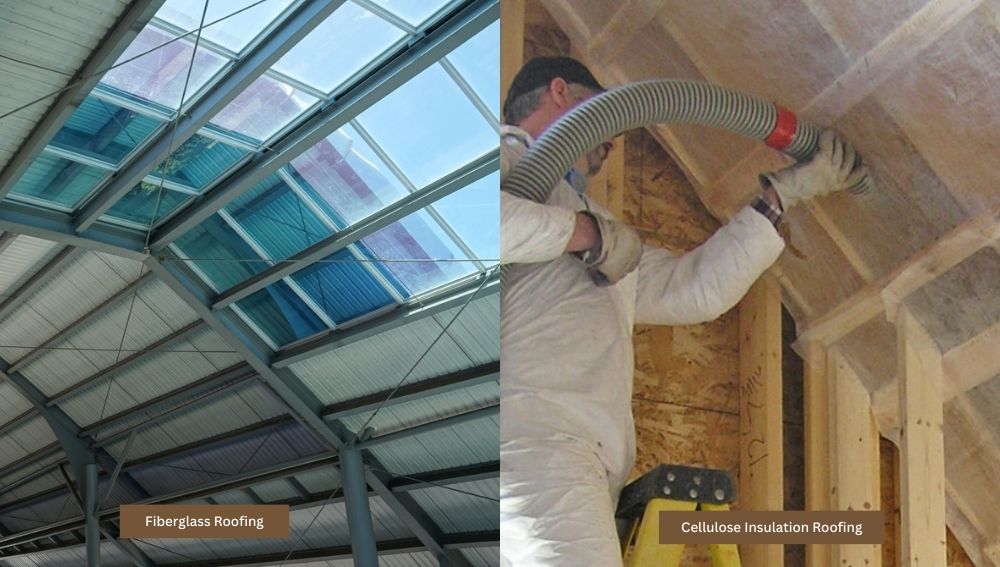
Fiberglass and cellulose insulation are two common types of insulation used in roofing systems. Each type has its own characteristics and benefits. Here is all you need to know about fiberglass and cellulose insulation roofing systems:
Material: Fiberglass insulation is made from tiny fibers of glass that are woven together to create a blanket-like material.
Installation: It is installed in the roof cavities or between the roof trusses or joists. It is available in rolls or batts that can be easily cut and fitted into place.
Thermal insulation: Fiberglass insulation has excellent thermal insulation properties, helping to maintain a comfortable indoor temperature and reduce energy consumption.
Moisture resistance: Fiberglass does not absorb moisture, so it resists mold and mildew growth.
Fire resistance: It is non-combustible and can help slow the spread of fire in a building.
Acoustic insulation: Fiberglass insulation can reduce noise transmission, making it suitable for both thermal and acoustic insulation requirements.
Material: Cellulose insulation is made from recycled paper products treated with flame retardant chemicals to increase fire resistance.
Installation: It can be blown or sprayed into the roof cavities, providing a seamless and effective insulation layer.
Environmentally friendly: Cellulose insulation is made from recycled materials, reducing the environmental impact.
High thermal resistance: It has a higher R-value (insulating effectiveness) than fiberglass, providing better thermal insulation.
Soundproofing: Cellulose insulation can reduce noise transmission, improving acoustic comfort.
Fire retardant: Treated with fire retardant chemicals, cellulose insulation has good fire resistance properties.
Moisture management: Proper vapor barriers and ventilation systems should be in place to prevent moisture build-up and potential damage to the insulation.
Installation: Proper installation is crucial to achieve maximum insulation effectiveness. It is advisable to consult with insulation professionals for proper installation techniques and adherence to local building codes and regulations.
Energy efficiency: Both fiberglass and cellulose insulation contribute to energy efficiency by reducing heat transfer and improving indoor comfort.
Fiberglass and cellulose insulation roofing systems are effective methods to improve energy efficiency, thermal comfort, and noise reduction in buildings. The choice between the two should be based on factors such as budget, insulation requirements, environmental impact, and local regulations. Consulting with insulation professionals can help determine the most suitable option for your roofing system and specific needs.
14. Thatched roofing (typically made from straw or reed)
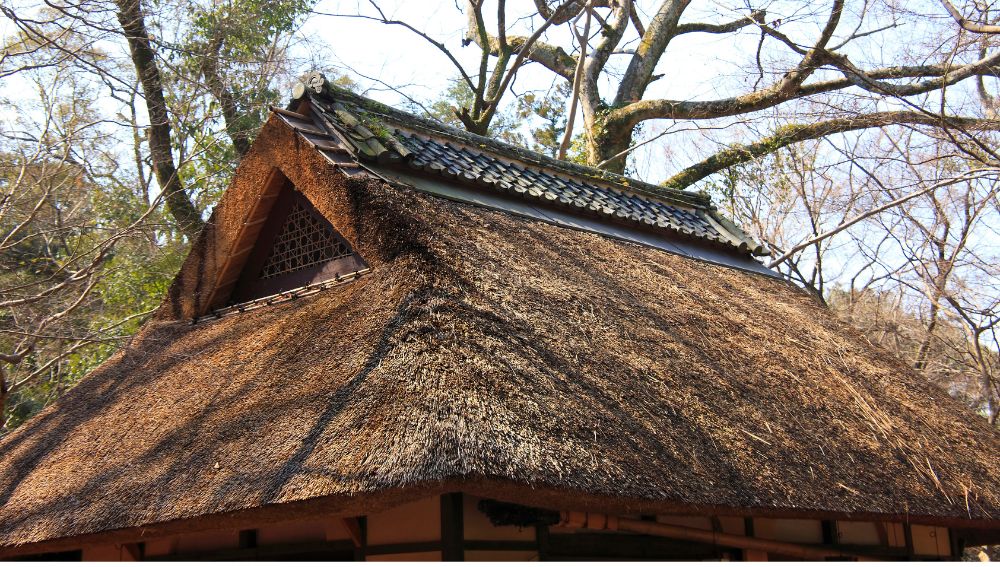
Thatched roofing is a traditional roofing method that involves using straw or reed to create a waterproof and durable roof covering. It has been used for centuries and continues to be popular in certain areas due to its unique aesthetic appeal and cultural significance. Here is all you need to know about thatched roofing made from straw or reed:
Straw: Various types of straw, such as wheat, barley, rice, or rye straw, are traditionally used for thatching. Straw is a readily available and affordable material.
Reed: Water reed (phragmites australis) is the most commonly used reed material for thatched roofs. It is known for its durability and resistance to weathering.
Bundles: The thatcher typically bundles the straw or reed into compact bundles, which are then attached in overlapping layers to the roof structure, starting from the eaves and working upwards.
Roof structure: Thatched roofs require a steep pitch to allow rainwater to run off quickly. A solid roof structure with a sturdy framework is essential to support the weight of the thatch.
Layers and fixings: The thatch is layered in horizontal rows, with each new layer fixed securely in place using thatching spars or twisted wire. Thatch fixings should be concealed to maintain the traditional appearance.
Natural insulation: Thatched roofs provide excellent thermal insulation, keeping the interior cool during summer and warm during winter.
Sustainability: Using natural and renewable materials like straw or reed makes thatched roofing an environmentally friendly choice.
Aesthetic appeal: Thatched roofs have a unique and rustic appearance, adding charm, character, and a sense of tradition to buildings.
Breathability: Thatch allows the roof to breathe, which helps to regulate moisture levels and prevent condensation.
Longevity: A well-maintained thatched roof can last for several decades, although the lifespan depends on factors such as climate, maintenance, and the quality of the materials used.
Regular maintenance is crucial to ensure the longevity and performance of a thatched roof. Maintenance tasks may include re-thatching worn areas, replacing damaged thatch, and treating the roof with fire retardant solutions.
Thatched roofs require periodic inspection to identify and rectify any potential issues like moss growth, bird nests, or deterioration.
Local regulations: Thatched roofing may be subject to specific regulations and may require permits or approvals, depending on the area.
Fire safety: Thatched roofs are more susceptible to fire than other roofing materials. It is important to install fire retardant treatments, have proper fire safety measures in place, and comply with local fire codes.
Thatched roofing made from straw or reed is a traditional and visually appealing roofing option. Its unique character, natural insulation properties, and cultural significance make it popular in certain regions. However, it requires regular maintenance and careful consideration of fire safety measures. Consulting with experienced thatchers and understanding local regulations are essential before choosing a thatched roof for your building.
Eco-friendly Roofing Materials
A cool roof is an eco-friendly roof. It is one of the popular choices.
It is a mixture of white glue and gravel that helps reflect the sun’s rays. The house has less heat penetration, meaning less air conditioning and electricity.
- Wood shingles
Wood shingles are durable and eco-friendly because they can be recycled into wood that people can use in their homes.
- Metal roofing
Metal roofing is also reflective, which keeps the house cool and limits the need for air conditioners.
- Clay tiles
Clay tiles are also eco-friendly and energy efficient. They allow air to circulate, and they’re low maintenance.
Steep Slope VS Low Slope Roofing
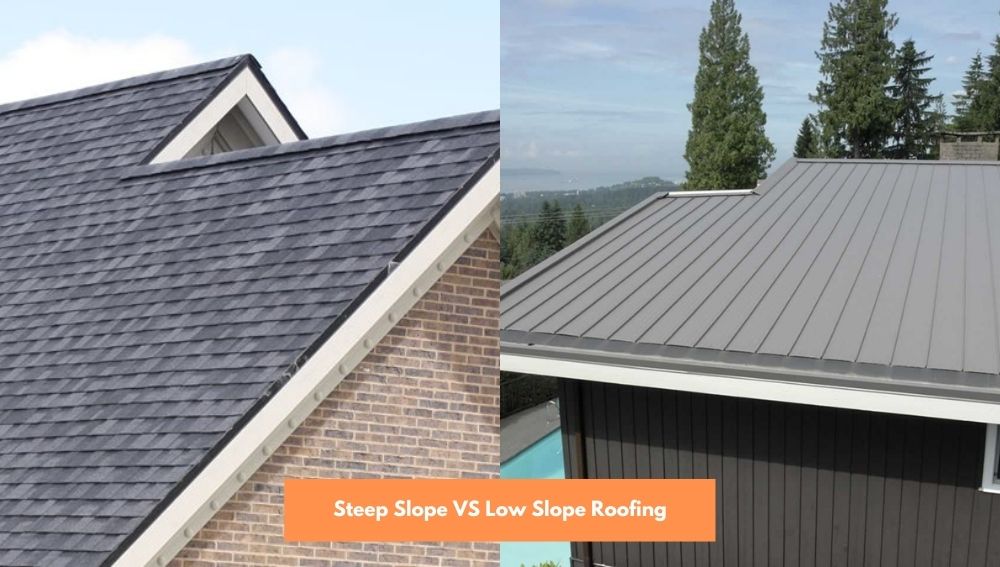
Roofs all serve the same purpose, to protect the building. Still, all roofs are different as they were designed from other materials and designs. There are roofs with slopes classified into steep and low slope roofing.
Let’s see the difference between steep-slope and low-slope roofing.
The first difference between them is the position. A steep slope roofing has an 18 degrees pitch and sometimes more, used on residential buildings. In comparison, low-slope roofing has a rise of below 18 degrees. The low slope roofing is a flat roof.
Common materials used for steep slopes are;
- Asphalt shingles
- Brick tiles
- Metal
Common materials used for low-slope roofing
- Metal JSW color-coated sheets
- Modified bitumen
- Bitumen consists of roofing sheets created from asphalt modified with rubber or plastic.
- Built-Up roofs(BUR)
- It’s a combination of bitumen and reinforcing fabrics
- It’s a multilayer system that creates protection.
- Rolled roofing
- It is a mineral-based asphalt that comes in rolls
- Single ply
- Thermoplastic polyolefin(TPO)
- Ethylene Propylene Diene Monomer(EPDM)
- Polyvinyl chloride (PVC)
Choosing the suitable roofing material for a low slope is crucial because this type of roof is exposed to many things, including water, UV rays, debris, etc.
Another difference between the two is the water flow. Rainwater does not stay on the steep slope, which helps improve its durability, but water stays long on the low slope roofs, leading to leaks and water damage. Stagnant water has been a significant concern for homeowners. Nobody wants a pool of water on their roof after heavy rainfall.
Low-slope roofing takes a simple system. The materials are less expensive, making the low slope less expensive. The steep slope roofing requires more labor due to its height and a more complex installation process.
Polycarbonate roofs are known to be one of the best options perfect for both steep slope and low slope roofing.
Homeowners with steep slopes can design and show their roofing system. Still, low-slope roofs have less visibility to showcase anything.
Four Best Roofing Materials For Hot Climates
Your roof, your first defense against the sun, slows heat transfer into your home. It is crucial to select the best roofing materials for hot climates if you live in such areas.
Asphalt shingles
Certain types of asphalt shingles can reflect sunlight, as a result of this preventing heat absorption.
Metal
Metal roofing reflects sunlight, forming a thermal barrier keeping your building cool.
Clay tiles
Clay tiles have good airflow, and this helps to make your house cooler
Green roofing
Green roofing is an environmentally friendly material that is great for hot climates. It regulates heat temperature and absorption and cools the building.
Roofing Materials Ideal For Wind And Fire-prone Areas
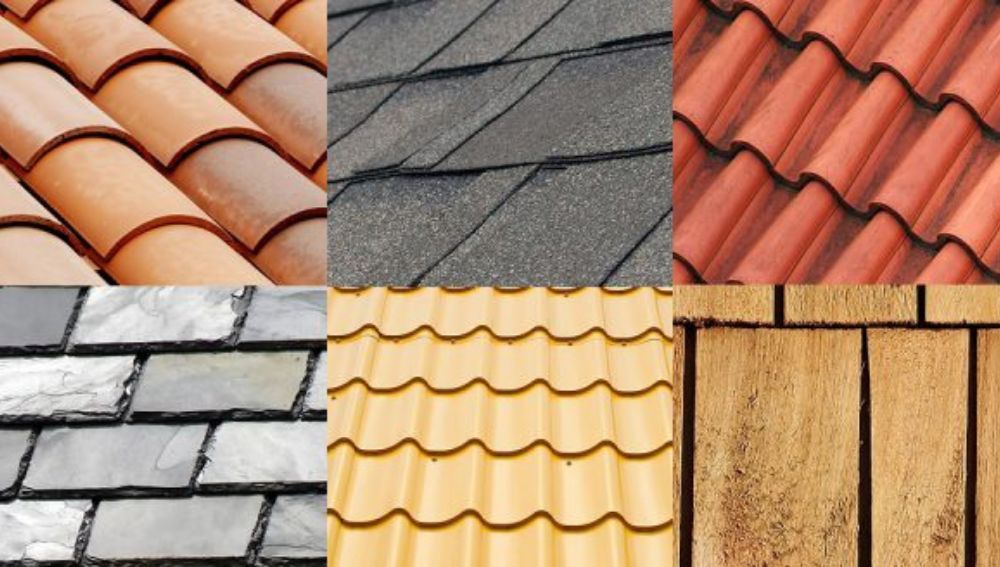
When looking for roofing materials, it’s essential to consider natural disasters such as wind and fire.
Wind causes significant damage to roofs, most especially during severe storm attacks, and fire can ruin everything.
You need materials resistant to these elements to help protect your home, and you can have a certain amount of peace of mind.
- Metal roofing
Metal roofing is both wind and fire-resistant. It is firm and can withstand wind up to 140 miles per hour. The strength makes it a perfect choice for people in areas prone to hurricanes. Metal roofing is also fire resistant and reflects heat, making it an excellent choice for areas prone to wildfire.
- Tile Roofing
Tile roofing is also a good material for wind and fire. Tile roofs are made of clay or concrete and can withstand wind up to 150 miles per hour. Tiles are fire-resistant and durable, lasting up to 50 years.
- Slate roofing
Slate roofing is both wind and fire-resistant. Slate roofing is an ideal option for people in wildfire areas, and it can hold winds of up to 130 miles per hour.
Roofing Materials Suitable For Heavy Rain
Your roofing is your house’s number one defense against nature. When choosing a roofing material suitable for rainy weather environments, select a waterproof material that can handle heavy rain without leaking or sustaining damage.
Below are some roofing materials that have these attributes and can withstand rainstorms
- Metal roofing
Metal roofing is a durable, strong option with heavy rain. It has a waterproof design, and It can prevent leaks and water damage.
- Asphalt shingles
Asphalt shingle is an affordable option to hold heavy rain without falling apart. It is waterproof and leakproof.
- Clay and concrete tiles
They are a solid, durable option that withstands heavy rain and wind. They are also leak proof and waterproof.
- Synthetic roofing materials.
Synthetic roofing materials such as PVC and TPO are manufactured to withstand rainstorms and are waterproof; being lightweight is a plus.
- Slate roofing
Slate is an excellent choice for rainy climates; though expensive, but very effective.
You might need a professional to properly assess your needs and choose the proper protection material for your building.
Sustainable Roofing Materials
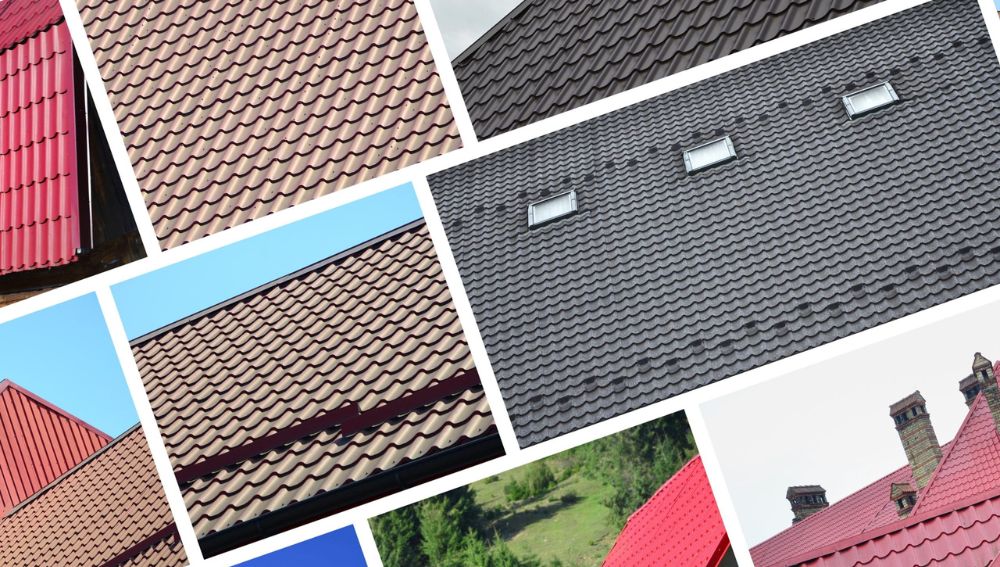
Sustainability is not only restricted to green or living roofs. There is also a broad category that includes many roofing materials.
What Makes Roofing Materials Sustainable?
It’s not only the raw materials of the roofing material that makes it environmentally friendly but also how it works over its lifespan.
Sustainable materials are produced without destroying the resources, and it does little or no harm to the earth.
Any roofing material that uses fuel or mined materials is not sustainable because the source was destroyed.
Comparing Roofing Materials Sustainability
- Metal roofing
Metal roofs are long-lasting, attractive, and contain highly recyclable materials that can be easily recycled at the end of their lifespan.
Metal is highly conductive to heat, so it must be appropriately insulated.
Steel and aluminium are the two standard metal roofings; these materials are obtained from the earth, making them unsustainable.
- Slate roofing
Slate roofing is expensive and heavyweight. It also takes a lot of resources to mine. Mining is not a sustainable practice, equating to slate roofing not being sustainable.
- Clay tiles
Clay tiles are durable and made with naturally shaped and fired clay. Clay is a resource that is in abundance, so people claim clay tiles to be sustainable.
- Wood shakes and shingles
Wood shakes are the most unarguable sustainable roofing material, and wood is a sustainable material.
Destroying wood roofing is easy because wood is a biodegradable material.
- Asphalt shingles
Asphalt shingles are made with paper, minerals, fiberglass, tar, and petroleum products.
Shingles are not biodegradable, and they are not recyclable because petroleum, which is their based product, is not recyclable. Asphalt shingles are not sustainable.
- Concrete tiles
Concrete tiles are made with cement which is highly intensive to produce, and it also emits CO2, which is a greenhouse gas. Concrete tiles are heavy and highly durable.
- Green roofing
Green roofs are flat roofs that are covered in grass or plants. The green roof offers many benefits, including providing insulation and absorbing rainwater, amongst other things.
A downside is that green roofs rely on heavy rubber membrane to waterproof their roof, which is made of petroleum and not sustainable.
Tips For Choosing A Sustainable Roofing Material
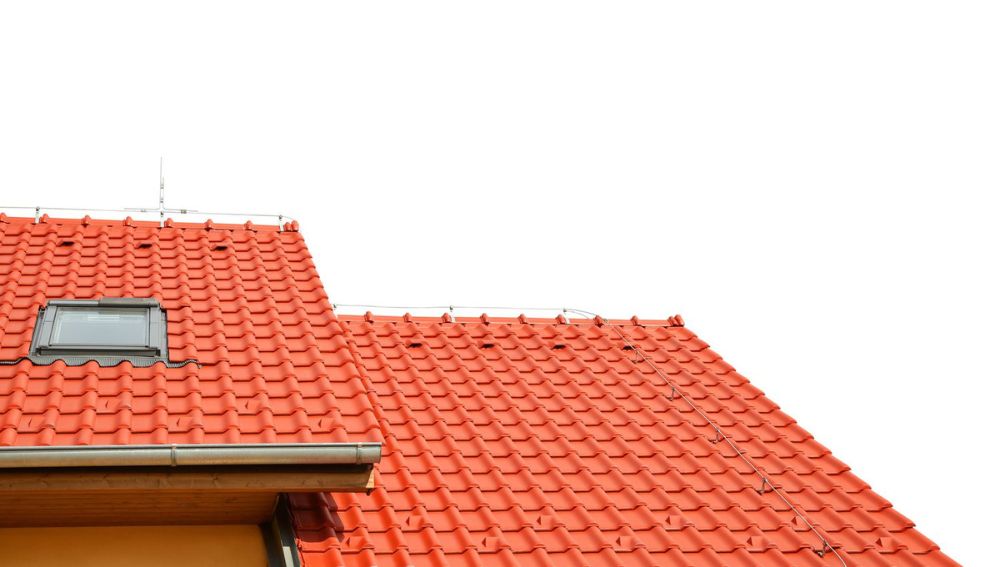
- Check the material to see if it contains materials that can be recycled. Research well to see if the material can be recycled.
- Please avoid roofing materials coated in copper or zinc because washing them into a water source could be deadly to aquatic life.
- Check to know if your roofing material needs toxic products to maintain it. Suppose it doesn’t; look for another one with a less time-consuming maintenance process.
- Heavy roofing materials are advisable because they can’t fly off during a windstorm. Still, you must ensure your house structure can support it.
- Choose roofing materials with an extended warranty period to be more durable.
Environmental Impact To Consider When Choosing A Roofing Material
- Sustainable energy management
Some roofing materials are highly reflective and can help to reduce cooling costs.
Example: Metal and tiles
- Capacity to endure over time
Choosing materials that last long will reduce replacement and also minimize waste and resources from replacement
Example:Slate metal
- The ability to be reused
It’s advisable to choose materials that can be recycled and used again. The recyclable factor will help reduce the waste that goes to landfills.
Example: Metal and asphalt
- Renewable resources
There are renewable roofing materials that are renewable. They are resources that people can sustainably harvest. E.g., Wood shakes and shingles
- Environmental impact of production
Manufacturing some roofing materials has a significant environmental impact, including pollution and using energy and resources.
- Green roofing
The use of green roofing can reduce energy consumption and improve air quality, amongst other environmental benefits.
Your home is a long-term investment, and it’s important to seal it up with the best roofing materials to protect it.
Here Are Factors To Consider When Picking A Roofing Material
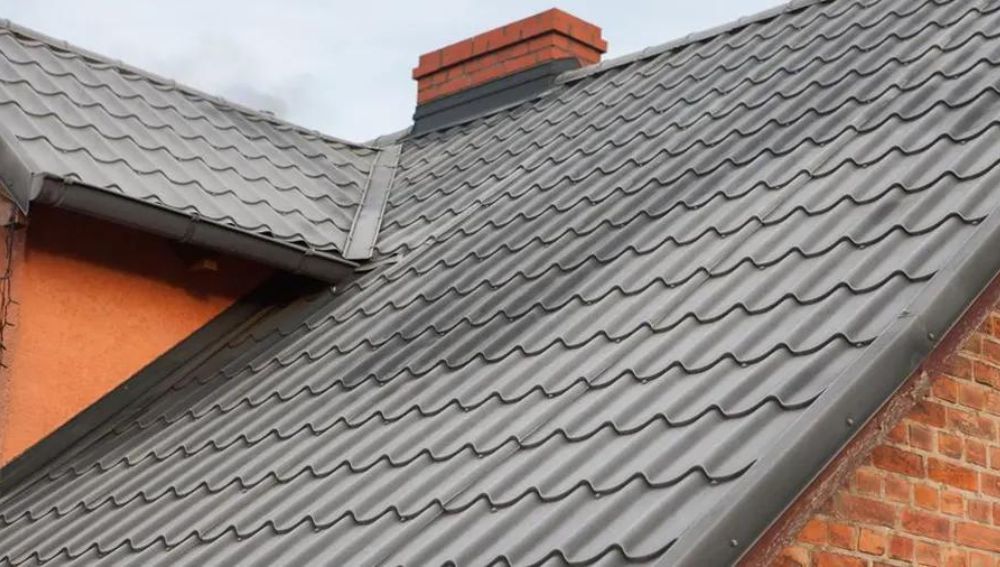
- Cost of purchase
Before you start, you should have a budget of what you’re willing to spend on the house. Your budget helps you in the direction that you should go. You should know that a costly material does not guarantee durability, and a less expensive one does not necessarily mean it’s of less quality.
- Continuous upkeep and maintenance
Pick a roofing material that suits your schedule. If you’re busy, it automatically means you only have a little time to care for your roof, so pick one that only needs a little maintenance. Metal is a good material that does not require much work, so it’s best for busy homeowners.
- Shape of the building
The shape of your building/ roof determines the roofing materials you’ll get. Not all roofing materials are suitable for all kinds of roofs. The roof used in a commercial building might differ from that used in a residential building.
- Style and design of the building
The style and design of your building are factors to be considered by homeowners. Some materials can’t be used with a particular house design, e.g., modern houses and traditional houses, they already have a theme, so it’s just best to stick to it so that the house does not have an odd appearance.
- Requirement of your community
Some communities have rules and regulations guiding their buildings. You should consult your local building codes and regulations to ensure you get suitable materials.
- Climate conditions and changes
A critical factor to consider is the weather. What is the weather condition in your environment? Get a roofing material that can withstand the weather pressure in your environment. Certain roofing materials work better in certain climates than others.
- Weight of the materials
Roofing materials weigh more than each other, and some are heavier than others, e.g., green roofing is weighty than others, requiring extra support structure.
Picking the right weight can help your building. Check well to know If your building has the structure to support the weight of the roofing materials; if not, you might need additional structural support.
- Resistance to fire and flames
If you live in areas prone to wildlife, you need to be careful of the type of roofing materials you use. Some roofing materials are more vulnerable to fire.
- Process of installing
What is the installation process? Know that some materials have long and tedious installation processes. Some even require expertise and specific tools, which can increase your labor force and cost.
- Availability of the materials
Some roofing materials are more difficult to find in certain areas, and it’s advisable to go with materials that can easily be found in your area to shorten your installation process and the cost of materials.
Considering all these factors, you can make a more informed decision.
Cost of Roofing Materials
The cost of a roof replacement varies widely. But some factors that determine the cost include the type of roofing materials installed, the size and shape of your roof, home size, slope of the roof, local labor prices, and other factors.
A home roof replacement costs between $5,400 to $19,800 on average as of 2023.
But it can also range from $4,500 to as much as $30,000.
Which Roofing Material Is The Best?
There is no single best roofing material. All the roofing materials have their strengths and areas they lack. There is a roofing material that is perfect for you and your building, and the best roofing material depends on your needs and preferences. You can seek a professional to choose the best roof to serve your needs perfectly.
Note: Working with a professional to ensure you get the best material for your building is advisable.
How To Care For The Roof To Avoid Damage
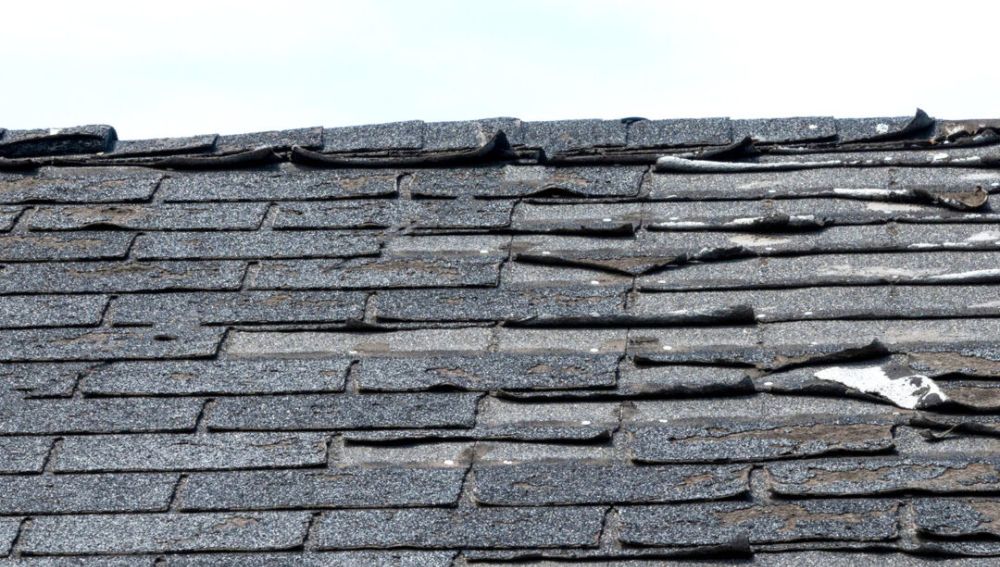
- Regular inspection
It’s advisable to inspect your roof at least twice a year, once at the beginning and the end of the year, and also after weather events such as heavy rain, windstorm, or snowfall. Check for signs of cracks, missing shingles, and any other damage
- Trim your trees
Cut off any hanging branches close to your roof. A tree branch could snap and fall on the roof causing it to get damaged, so regular trimming of branches and trees close to the roof can reduce the chances of damage.
- Clean gutters
Gutters help the roofing because it directs water off the roof, but if the drain is clogged, water will remain stagnant and won’t move from the top, which is unsuitable for the roof. So regular cleaning of the gutter will help the roof.
- Clean your roof regularly.
It is vital to clean periodically. Remove every leaf, twig, dirt, and debris from the roof regularly. By doing so, you’re protecting your roof from mold, lichen, and algae growth.
- Sufficient air flow
Ensure your roof is well-ventilated because proper ventilation will prevent moisture buildup, and lack of moisture will prevent mold growth.
- Repair any damage immediately
If you notice slight damage on the roof, repair it immediately before it escalates.
- Use of sealant and coating
Applying sealant and coating will add a protective layer to your roof, protecting it from harsh weather conditions.
- Professional inspection
It would be best to have your roof inspected by a professional every few years to check for signs of damage that professionals can only detect.
The processes can help prevent damage to your roof and prolong its lifespan.
When To Replace Your Roof
Replacing a roof is a significant project, and it can be expensive. But if you wait too long before you do it, it could lead to more damage and put you at risk.
Below are signs that you need to change your roof.
- Duration of existence
Every roof has a lifespan lasting between 20 to 25 years. If your roof is older than that, it’s time to start thinking of changing it before it caves in on you.
If you start to notice leaks, cracks, broken pieces of the roof, or extensive damage, it’s time for a change. If you ignore the damage, it will only worsen and might cost you even more damage.
- Water damage
If you notice water damage on your ceiling or walls or water stain, it’s a clear sign that your roof is leaking; change it to prevent further damage.
- Granule loss
If you notice a pile of granules around your house or on the gutter, your shingles are losing their protective granules and should be changed.
- Sagging of the roof
If you notice sagging, your roof has rotted due to trapped moisture and must be replaced.
- Curling shingles
When you notice that your shingles have started to curl, it is a sign that they are not correctly attached and are likely damaged; you need a professional to look at them.
- Missing shingles
The appearance of moss and fungi means that there is trapped moisture; you need to check it out to avoid more damage.
Do I Need A Professional To Fix My Roof, Or Can I Do It Myself?
You can do some random minor roof repairs, but having a professional handle is the best.
These roofing contractors have the needed expertise and tools to fix it.
They know the dos and don’t of the job; if anything were to go wrong, they would know how to maneuver and correct it.
If the roof is not installed correctly, it could lead to future problems. For example, suppose spaces were accidentally left when fixing the roof. In that case, water could get in and create moisture, leading to mold, rot, and other damage. Also, installing a roof on your own could compromise the insurance policy.
If you think the labor cost is much, think of how much it would cost to fix it if it was damaged again.
All home projects are essential and need to be done with care. Most homeowners hastily search for any available roofing constructor to get the work done; it’s not a good idea, but it has more disadvantages rather than advantages.
Choosing a good roof constructor requires research, time, and patience.
Tips For Hiring A Good Roofing Contractor

- Cross-check insurance and licensing
Look for a reputable contractor and check their license. Please take your time to research the contractor properly. Only work with contractors who can provide their insurance.
- Pick local contractor
Use local roofing companies. Picking a local contractor will reduce your risk of falling prey to scammers. A local contractor is familiar with the rules and regulations in the community. They know of all the weather conditions and know which roof is best to withstand them, and they have a good relationship with the area’s suppliers and crew. You can get your materials at a discounted rate.
- Check for experience
Hire a contractor with long roof construction experience who will likely do a good job. The constructors might charge higher, but you’ll be satisfied with the results you’ll get.
- Go through their past work as a reference
A contractor’s work will always speak for them. It will show in their work if they are as good as they say. Go through their site and portfolio and talk with someone who has used their service to ensure you’re on the right path
- Review the contract and warranties carefully before you commit
Check and read every contract repeatedly until there’s nothing else to read. Understand the warranty period that came with your new roof.
Beware of constructors who want you to sign hastily.
Focus on something other than the price. Most times, it’s about something other than money. Pick a roofing contractor who offers the best value for your money.
Conclusion
In conclusion, selecting suitable roofing materials for your home is vital and should be done wisely and carefully. Not only does it protect your home, but it also adds to the house’s overall appearance.
From asphalt shingles to wood shingles, there are a variety of roofing materials to pick from, each with its disadvantages and benefits.
It’s essential to keep those factors such as type of material, cost, durability, aesthetics, maintenance, and environmental impact in mind. Also, the roof’s proper installation and maintenance process determines how long it will last.
Finally, as the world has become more environmentally conscious and we’re caring for our environment, you need to consider roofing materials that positively impact the environment.

